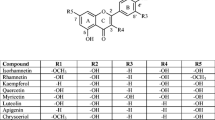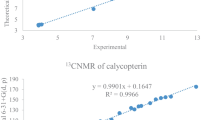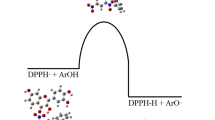Abstract
The structural and antioxidant activity of two flavonols, namely, Fisetin and Robinetin, have been investigated employing the density functional theory (DFT) using B3LYP functional and 6–311++G (d, p) basis set. The calculations were performed in the gas phase and under the solvent effect of water, dimethylsulfoxide (DMSO), methanol, and benzene. The hydrogen-atom transfer (HAT), single electron transfer followed by proton transfer (SET-PT), and sequential proton loss electron transfer (SPLET) mechanisms were investigated to rationalize the radical scavenging capacities and to identify the favored antioxidant mechanism. Hence, the bond dissociation enthalpies (BDE) ionization potential (IP), IE, proton dissociation enthalpy (PDE), proton affinity (PA), and electron transfer enthalpy (ETE) related to each mechanism were reported and discussed in function of the solvent effect. For both flavonols, the results showed that 4′-OH hydroxyl is the preferred active site following the trend 4′-OH > 3′-OH > 3-OH > (5′-OH) > 7-OH. Besides, the HAT mechanism is energetically the most favored pathway. The energetically favored solvents follow the trends water > DMSO > benzene > methanol and benzene > DMSO > methanol > water, for Fisetin and Robinetin, respectively.
Graphical abstract









Similar content being viewed by others
Data availability
All data generated or analyzed during this study are included in this published article.
References
Rusznyák ST, Szent-Györgyi A (1936) Vitamin P: Flavonols as vitamins. Nature 138:27–27. https://doi.org/10.1038/138027a0
Mukohata Y, Nakabayashi S, Higashida M (1978) Quercetin, an energy transfer inhibitor in photophosphorylation. FEBS Lett 85:215–218
Lee E-R, Kang G-H, Cho S-G (2007) Effect of flavonoids on human health: old subjects but new challenges. Recent Pat Biotechnol 1:139–150
Hollman PCH, Katan MB (1999) Dietary flavonoids: intake, health effects and bioavailability. Food Chem Toxicol 37:937–942
Pandey KB, Rizvi SI (2009) Plant polyphenols as dietary antioxidants in human health and disease. Oxid Med Cell Longev 2:270–278. https://doi.org/10.4161/oxim.2.5.9498
Wolfe KL, Liu RH (2008) Structure−activity relationships of flavonoids in the cellular antioxidant activity assay. J Agric Food Chem 56:8404–8411
Wolfe KL, Liu RH (2007) Cellular antioxidant activity (CAA) assay for assessing antioxidants, foods, and dietary supplements. J Agric Food Chem 55:8896–8907
Wolfe KL, Kang X, He X et al (2008) Cellular antioxidant activity of common fruits. J Agric Food Chem 56:8418–8426. https://doi.org/10.1021/jf801381y
Liu RH (2004) Potential synergy of phytochemicals in cancer prevention: mechanism of action. J Nutr 134:3479S-3485S. https://doi.org/10.1093/jn/134.12.3479S
Harborne JB, Williams CA (2000) Advances in flavonoid research since 1992. Phytochemistry 55:481–504. https://doi.org/10.1016/s0031-9422(00)00235-1
de Vrie JHM, de Vrie JHM, Karin Janssen PLT et al (1997) Consumption of quercetin and kaempferol in free-living subjects eating a variety of diets. Cancer Lett 114:141–144
Mullie P, Clarys P, Deriemaeker P, Hebbelinck M (2007) Estimation of daily human intake of food flavonoids. Plant Foods Hum Nutr 62:93–98
Jun S, Shin S, Joung H (2016) Estimation of dietary flavonoid intake and major food sources of Korean adults. Br J Nutr 115:480–489
Teixeira S, Siquet C, Alves C et al (2005) Structure-property studies on the antioxidant activity of flavonoids present in diet. Free Radic Biol Med 39:1099–1108. https://doi.org/10.1016/j.freeradbiomed.2005.05.028
Bubols GB, da Vianna DR, Medina-Remon A et al (2013) The antioxidant activity of coumarins and flavonoids. Mini Rev Med Chem 13:318–334. https://doi.org/10.2174/138955713804999775
Chahar MK, Sharma N, Dobhal MP, Joshi YC (2011) Flavonoids: a versatile source of anticancer drugs. Pharmacogn Rev 5:1–12. https://doi.org/10.4103/0973-7847.79093
Galati G, O’Brien PJ (2004) Potential toxicity of flavonoids and other dietary phenolics: significance for their chemopreventive and anticancer properties. Free Radical Biol Med 37:287–303
Plate AYA (2006) Cruciferous vegetables, secondary metabolites of glucosinolates, and colon cancer risk in rats. University of Minnesota
Mekhancha-Dahel CC (2008) Anthropométrie nutritionnelle et santé des sujets jeunes: données actuelles dans le monde et en Algérie. Editions Dar El Gharb
Kuntz S, Wenzel U, Daniel H (1999) Comparative analysis of the effects of flavonoids on proliferation, cytotoxicity, and apoptosis in human colon cancer cell lines. Eur J Nutr 38:133–142. https://doi.org/10.1007/s003940050054
Huang YT, Hwang JJ, Lee PP et al (1999) Effects of luteolin and quercetin, inhibitors of tyrosine kinase, on cell growth and metastasis-associated properties in A431 cells overexpressing epidermal growth factor receptor. Br J Pharmacol 128:999–1010. https://doi.org/10.1038/sj.bjp.0702879
Bais HP, Weir TL, Perry LG et al (2006) The role of root exudates in rhizosphere interactions with plants and other organisms. Annu Rev Plant Biol 57:233–266
Mierziak J, Kostyn K, Kulma A (2014) Flavonoids as important molecules of plant interactions with the environment. Molecules 19:16240–16265. https://doi.org/10.3390/molecules191016240
Mantas A, Deretey E, Ferretti FH et al (2000) Structural analysis of flavonoids with anti-HIV activity. Theochem 504:171–179. https://doi.org/10.1016/s0166-1280(00)00362-6
Wu J-H, Wang X-H, Yi Y-H, Lee K-H (2003) Anti-AIDS agents 54. A potent anti-HIV chalcone and flavonoids from genus Desmos. Bioorg Med Chem Lett 13:1813–1815. https://doi.org/10.1016/s0960-894x(03)00197-5
Khan N, Syed DN, Ahmad N, Mukhtar H (2013) Fisetin: a dietary antioxidant for health promotion. Antioxid Redox Signal 19:151–162
Bouzid K, Toumi Benali F, Chadli R, Bouzouina M, Bouzid A, Benchohra A, Dif MM (2014) Extraction, identification and quantitative HPLC analysis of flavonoids from fruit extracts of Arbutus unedo L. from Tiaret area (Western Algeria). Eur J Mol Biotechnol 6:160–169
Pahari B, Chakraborty S, Chaudhuri S et al (2012) Binding and antioxidant properties of therapeutically important plant flavonoids in biomembranes: insights from spectroscopic and quantum chemical studies. Chem Phys Lipids 165:488–496. https://doi.org/10.1016/j.chemphyslip.2011.10.006
Kim JY, Jeon YK, Jeon W, Nam MJ (2010) Fisetin induces apoptosis in Huh-7 cells via downregulation of BIRC8 and Bcl2L2. Food Chem Toxicol 48:2259–2264. https://doi.org/10.1016/j.fct.2010.05.058
Park H-H, Lee S, Oh J-M et al (2007) Anti-inflammatory activity of Fisetin in human mast cells (HMC-1). Pharmacol Res 55:31–37. https://doi.org/10.1016/j.phrs.2006.10.002
Brinkworth RI, Stoermer MJ, Fairlie DP (1992) Flavones are inhibitors of HIV-1 proteinase. Biochem Biophys Res Commun 188:631–637. https://doi.org/10.1016/0006-291x(92)91103-w
Maher P, Akaishi T, Abe K (2006) Flavonoid Fisetin promotes ERK-dependent long-term potentiation and enhances memory. Proc Natl Acad Sci U S A 103:16568–16573. https://doi.org/10.1073/pnas.0607822103
Hillis WE (1996) Formation of Robinetin crystals in vessels of Intsia species. IAWA J 17:405–419
Heim KE, Tagliaferro AR, Bobilya DJ (2002) Flavonoid antioxidants: chemistry, metabolism and structure-activity relationships. J Nutr Biochem 13:572–584. https://doi.org/10.1016/s0955-2863(02)00208-5
Procházková D, Boušová I, Wilhelmová N (2011) Antioxidant and prooxidant properties of flavonoids. Fitoterapia 82:513–523. https://doi.org/10.1016/j.fitote.2011.01.018
Rahman K (2007) Studies on free radicals, antioxidants, and co-factors. Clin Interv Aging 2:219–236
Fridovich I (1999) Fundamental aspects of reactive oxygen species, or what’s the matter with oxygen? Ann N Y Acad Sci 893:13–18. https://doi.org/10.1111/j.1749-6632.1999.tb07814.x
Imbalance in antioxidant defence and human diseases: multiple approach of natural antioxidants therapy (2021) https://paperpile.com/app/p/a6f0664f-d5cb-07a2-ab0c-817300092165. Accessed 17 Nov 2021
Marković ZS, Mentus SV, Dimitrić Marković JM (2009) Electrochemical and density functional theory study on the reactivity of Fisetin and its radicals: implications on in vitro antioxidant activity. J Phys Chem A 113:14170–14179
Maciel EN, Soares IN, da Silva SC, de Souza GLC (2019) A computational study on the reaction between Fisetin and 2,2-diphenyl-1-picrylhydrazyl (DPPH). J Mol Model 25:103. https://doi.org/10.1007/s00894-019-3969-8
Bayat A, Fattahi A (2017) A quantum chemical study on the OH radical quenching by natural antioxidant Fisetin. J Phys Org Chem 30:e3692. https://doi.org/10.1002/poc.3692
Dimitrić Marković JM, Amić D, Lučić B, Marković ZS (2014) Oxidation of kaempferol and its iron(III) complex by DPPH radicals: spectroscopic and theoretical study. Monatsh Chem 145:557–563. https://doi.org/10.1007/s00706-013-1135-z
Spiegel M, Andruniów T, Sroka Z (2020) Flavones’ and flavonols’ antiradical structure-activity relationship-a quantum chemical study. Antioxidants (Basel) 9. https://doi.org/10.3390/antiox9060461
Dimitrić Marković JM, Marković ZS, Brdarić TP, Filipović ND (2011) Comparative spectroscopic and mechanistic study of chelation properties of Fisetin with iron in aqueous buffered solutions. Implications on in vitro antioxidant activity. Dalton Trans 40:4560–4571. https://doi.org/10.1039/c0dt01834a
Kakiuchi T, Mukai K, Ohara K, Nagaoka S-I (2009) Tunneling effect in antioxidant reaction of flavonoid. Bull Chem Soc Jpn 82:216–218
Naeimi AF, Alizadeh M (2017) Antioxidant properties of the flavonoid Fisetin: an updated review of in vivo and in vitro studies. Trends Food Sci Technol 70:34–44. https://doi.org/10.1016/j.tifs.2017.10.003
Lučić B, Stepanić V, Plavšić D et al (2014) Correlation between 13C NMR chemical shifts and antiradical activity of flavonoids. Monatsh Chem 145:457–463. https://doi.org/10.1007/s00706-013-1130-4
Manrique-de-la-Cuba MF, Gamero-Begazo P, Valencia DE et al (2019) Theoretical study of the antioxidant capacity of the flavonoids present in the Annona muricata (Soursop) leaves. J Mol Model 25:200. https://doi.org/10.1007/s00894-019-4083-7
Sadasivam K, Jayaprakasam R, Kumaresan R (2012) A dft study on the role of different oh groups in the radical scavenging process. J Theor Comput Chem 11:871–893. https://doi.org/10.1142/s0219633612500599
Hossen J, Ali MA, Reza S (2021) Theoretical investigations on the antioxidant potential of a non-phenolic compound thymoquinone: a DFT approach. J Mol Model 27:173. https://doi.org/10.1007/s00894-021-04795-0
Mendes RA, E Silva BLS, Takeara R et al (2018) Probing the antioxidant potential of phloretin and phlorizin through a computational investigation. J Mol Model 24:101. https://doi.org/10.1007/s00894-018-3632-9
Zheng Y-Z, Deng G, Liang Q et al (2017) Antioxidant activity of quercetin and its glucosides from propolis: a theoretical study. Sci Rep 7:7543. https://doi.org/10.1038/s41598-017-08024-8
Stewart JJP (2007) Optimization of parameters for semiempirical methods V: modification of NDDO approximations and application to 70 elements. J Mol Model 13:1173–1213. https://doi.org/10.1007/s00894-007-0233-4
Becke AD (1993) Density-functional thermochemistry. III. The role of exact exchange. J Chem Phys 98:5648–5652
Lee C, Yang W, Parr RG (1988) Development of the Colle-Salvetti correlation-energy formula into a functional of the electron density. Phys Rev B Condens Matter 37:785–789. https://doi.org/10.1103/physrevb.37.785
Vosko SH, Wilk L, Nusair M (1980) Accurate spin-dependent electron liquid correlation energies for local spin density calculations: a critical analysis. Can J Phys 58:1200–1211. https://doi.org/10.1139/p80-159
Zhao Y, Truhlar DG (2008) Density functionals with broad applicability in chemistry. Acc Chem Res 41:157–167. https://doi.org/10.1021/ar700111a
Hehre WJ, Ditchfield R, Pople JA (1972) Self—consistent molecular orbital methods. XII. Further extensions of Gaussian—type basis sets for use in molecular orbital studies of organic molecules. J Chem Phys 56:2257–2261. https://doi.org/10.1063/1.1677527
Ditchfield R, Hehre WJ, Pople JA (1971) Self-consistent molecular-orbital methods. IX. An extended Gaussian-type basis for molecular-orbital studies of organic molecules. J Chem Phys 54:724–728. https://doi.org/10.1063/1.1674902
gaussian 09, Revision d. 01, Gaussian (2021) https://paperpile.com/app/p/0de7953f-eccc-0633-9342-09859bebe6b9. Accessed 17 Nov 2021
Payán-Gómez SA, Flores-Holguín N, Pérez-Hernández A et al (2010) Computational molecular characterization of the flavonoid rutin. Chem Cent J 4:12. https://doi.org/10.1186/1752-153X-4-12
de Souza GLC, Peterson KA (2021) Benchmarking antioxidant-related properties for gallic acid through the use of DFT, MP2, CCSD, and CCSD(T) approaches. J Phys Chem A 125:198–208. https://doi.org/10.1021/acs.jpca.0c09116
Santos JLF, Kauffmann AC, da Silva SC et al (2020) Probing structural properties and antioxidant activity mechanisms for eleocarpanthraquinone. J Mol Model 26:233. https://doi.org/10.1007/s00894-020-04469-3
Mendes RA, Almeida SKC, Soares IN et al (2019) Evaluation of the antioxidant potential of myricetin 3-O-α-L-rhamnopyranoside and myricetin 4-O-α-L-rhamnopyranoside through a computational study. J Mol Model 25:89. https://doi.org/10.1007/s00894-019-3959-x
Maciel EN, Almeida SKC, da Silva SC, de Souza GLC (2018) Examining the reaction between antioxidant compounds and 2,2-diphenyl-1-picrylhydrazyl (DPPH) through a computational investigation. J Mol Model 24:218. https://doi.org/10.1007/s00894-018-3745-1
(1996) Ab initio study of solvated molecules: a new implementation of the polarizable continuum model. Chem Phys Lett 255:327–335. https://doi.org/10.1016/0009-2614(96)00349-1
Miertus̃ S, Tomasi J (1982) Approximate evaluations of the electrostatic free energy and internal energy changes in solution processes. Chem Phys 65:239–245. https://doi.org/10.1016/0301-0104(82)85072-6
Miertuš S, Scrocco E, Tomasi J (1981) Electrostatic interaction of a solute with a continuum. A direct utilizaion of AB initio molecular potentials for the prevision of solvent effects. Chem Phys 55:117–129. https://doi.org/10.1016/0301-0104(81)85090-2
Barone V, Cossi M, Tomasi J (1997) A new definition of cavities for the computation of solvation free energies by the polarizable continuum model. J Chem Phys 107:3210–3221. https://doi.org/10.1063/1.474671
Leopoldini M, Marino T, Russo N, Toscano M (2004) Antioxidant properties of phenolic compounds: H-atom versus electron transfer mechanism. J Phys Chem A 108:4916–4922
Kreilick RW, Weissman SI (1966) Hydrogen atom transfer between free radicals and their diamagnetic precursors. J Am Chem Soc 88:2645–2652
Buettner GR (1993) The pecking order of free radicals and antioxidants: lipid peroxidation, alpha-tocopherol, and ascorbate. Arch Biochem Biophys 300:535–543. https://doi.org/10.1006/abbi.1993.1074
Koopmans T (1934) Über die Zuordnung von Wellenfunktionen und Eigenwerten zu den Einzelnen Elektronen Eines Atoms. Physica 1:104–113. https://doi.org/10.1016/s0031-8914(34)90011-2
Messaadia L, Bekkar Y, Benamira M, Lahmar H (2020) Predicting the antioxidant activity of some flavonoids of Arbutus plant: a theoretical approach. Chemical Physics Impact 1:100007. https://doi.org/10.1016/j.chphi.2020.100007
Bitew M, Desalegn T, Demissie TB et al (2021) Pharmacokinetics and drug-likeness of antidiabetic flavonoids: molecular docking and DFT study. PLoS ONE 16:e0260853. https://doi.org/10.1371/journal.pone.0260853
Marković S, Tošović J (2015) Application of time-dependent density functional and natural bond orbital theories to the UV-vis absorption spectra of some phenolic compounds. J Phys Chem A 119:9352–9362. https://doi.org/10.1021/acs.jpca.5b05129
Seyoum A, Asres K, El-Fiky FK (2006) Structure-radical scavenging activity relationships of flavonoids. Phytochemistry 67:2058–2070. https://doi.org/10.1016/j.phytochem.2006.07.002
Leopoldini M, Marino T, Russo N, Toscano M (2004) Density functional computations of the energetic and spectroscopic parameters of quercetin and its radicals in the gas phase and in solvent. Theor Chem Acc 111:210–216. https://doi.org/10.1007/s00214-003-0544-1
Sadasivam K, Kumaresan R (2011) Antioxidant behavior of mearnsetin and myricetin flavonoid compounds–a DFT study. Spectrochim Acta A Mol Biomol Spectrosc 79:282–293. https://doi.org/10.1016/j.saa.2011.02.042
Sadasivam K, Kumaresan R (2011) A comparative DFT study on the antioxidant activity of apigenin and scutellarein flavonoid compounds. Mol Phys 109:839–852. https://doi.org/10.1080/00268976.2011.556576
Thong NM, Vo QV, Huyen TL et al (2019) Theoretical Study for exploring the diglycoside substituent effect on the antioxidative capability of isorhamnetin extracted from. ACS Omega 4:14996–15003. https://doi.org/10.1021/acsomega.9b01780
Dias MM, Machado NFL, Marques MPM (2011) Dietary chromones as antioxidant agents–the structural variable. Food Funct 2:595–602. https://doi.org/10.1039/c1fo10098j
Vagánek A, Rimarčík J, Dropková K et al (2014) Reaction enthalpies of OH bonds splitting-off in flavonoids: the role of non-polar and polar solvent. Comput Theor Chem 1050:31–38
Amić D, Lucić B (2010) Reliability of bond dissociation enthalpy calculated by the PM6 method and experimental TEAC values in antiradical QSAR of flavonoids. Bioorg Med Chem 18:28–35. https://doi.org/10.1016/j.bmc.2009.11.015
Alvareda E, Denis PA, Iribarne F, Paulino M (2016) Bond dissociation energies and enthalpies of formation of flavonoids: a G4 and M06–2X investigation. Comput Theor Chem 1091:18–23. https://doi.org/10.1016/j.comptc.2016.06.021
Parkinson CJ, Mayer PM, Radom L (1999) An assessment of theoretical procedures for the calculation of reliable radical stabilization energies †‡. J Chem Soc Perkin Trans 2:2305–2313
Acknowledgements
The authors thank Dr. Ahmed Abousafat and Dr. Durre Khalil for their technical English assistance. The calculations were performed thanks to the HPC resources of “Unité de Calcul intensif” of the University Frères Mentouri Constantine 1.
Author information
Authors and Affiliations
Contributions
All authors contributed to the study. The first draft of the manuscript was written by Rafik Menacer and all authors commented on previous versions of the manuscript. All authors read and approved the final manuscript. The credit author statement is as follows:
Rafik Menacer: writing—original draft, conceptualization, methodology, resources, data curation, software, investigation, formal analysis, visualization, validation, writing—review and editing. Rekkab Seifeddine: resources, data curation, software, investigation, visualization. Zahia Kabouche: supervision, validation, writing—review and editing.
Corresponding author
Ethics declarations
Conflict of interest
The authors declare no competing interests.
Additional information
Publisher's note
Springer Nature remains neutral with regard to jurisdictional claims in published maps and institutional affiliations.
Highlights
• The antioxidant activity of Fisetin and Robinetin compounds was theoretically rationalized under gas phase and solvent effect of water, dimethylsulfoxide (DMSO), methanol, and benzene at B3LYP/6-311++G(d, p) level of theory.
• The fundamental mechanisms related to the antioxidant activity: hydrogen-atom transfer (HAT), single electron transfer followed by proton transfer (SET-PT), and Sequential Proton Loss Electron Transfer (SPLET), were investigated. It was found that the HAT mechanism is thermodynamically the most favored pathway.
• The favorable active hydroxyls associated with the antioxidant activity follow the trend 4′-OH > 3′-OH > 3-OH > (5′-OH) > 7-OH.
• The energetically favored solvents follow the trends water > DMSO > benzene > methanol and benzene > DMSO > methanol > water for Fisetin and Robinetin, respectively.
Rights and permissions
About this article
Cite this article
Menacer, R., Rekkab, S. & Kabouche, Z. Fisetin and Robinetin antiradical activity under solvent effect: density functional theory study. J Mol Model 28, 240 (2022). https://doi.org/10.1007/s00894-022-05223-7
Received:
Accepted:
Published:
DOI: https://doi.org/10.1007/s00894-022-05223-7




